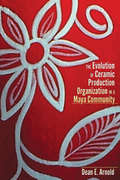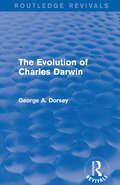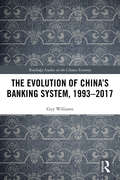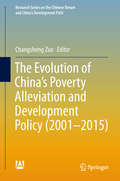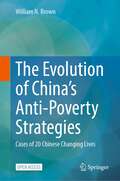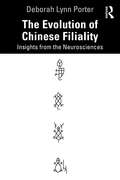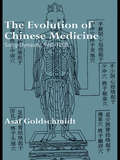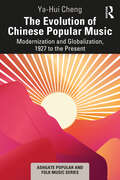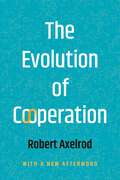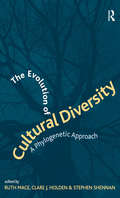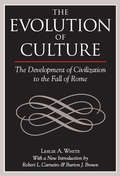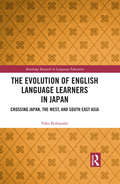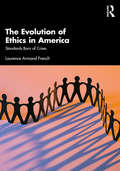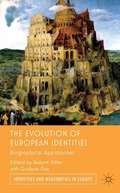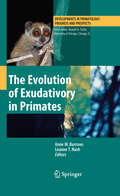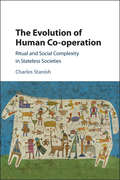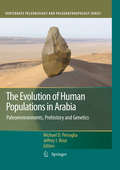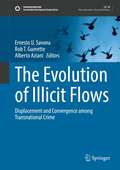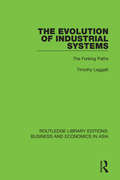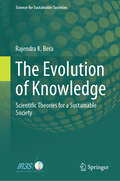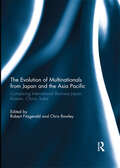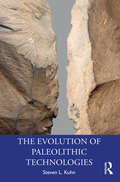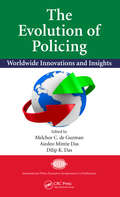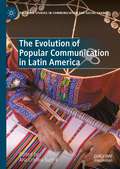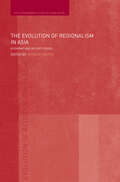- Table View
- List View
The Evolution of Ceramic Production Organization in a Maya Community
by Dean E. ArnoldIn The Evolution of Ceramic Production Organization in a Maya Community, Dean E. Arnold continues his unique approach to ceramic ethnoarchaeology, tracing the history of potters in Ticul, Yucatán, and their production space over a period of more than four decades. This follow-up to his 2008 work Social Change and the Evolution of Ceramic Production and Distribution uses narrative to trace the changes in production personnel and their spatial organization through the changes in production organization in Ticul. Although several kinds of production units developed, households were the most persistent units of production in spite of massive social change and the reorientation of pottery production to the tourist market. Entrepreneurial workshops, government-sponsored workshops, and workshops attached to tourist hotels developed more recently but were short-lived, whereas pottery-making households extended deep into the nineteenth century. Through this continuity and change, intermittent crafting, multi-crafting, and potters' increased management of economic risk also factored into the development of the production organization in Ticul. Illustrated with more than 100 images of production units, The Evolution of Ceramic Production Organization in a Maya Community is an important contribution to the understanding of ceramic production. Scholars with interests in craft specialization, craft production, and demography, as well as specialists in Mesoamerican archaeology, anthropology, history, and economy, will find this volume especially useful.
The Evolution of Charles Darwin (Routledge Revivals)
by George A. DorseyCharles Darwin is well-known throughout the world for his revolutionary work from 1859; The Origin of Species, the foundational study of evolution which greatly challenged the near-universal belief in the Christian world, at that time, of creationism. Originally published in 1928, Dorsey attempts to provide a detailed account of the scientist’s life and personality informed by letters, published works and an autobiography written by Darwin. Darwin’s life was full of challenges both in his personal life as well as his career and The Evolution of Charles Darwin explores all aspects of his life from birth to death emphasising the great impact his work had in the scientific community and humanity as a whole.
The Evolution of China's Banking System, 1993–2017 (Routledge Studies on the Chinese Economy)
by Guy WilliamsThis book traces the development of China’s banking system through the first 25 years of China’s socialist market economy up to the present. It examines how China’s leaders have chosen their own path for reforming and regulating the banking sector and shows how this approach has differed significantly from the neoliberal approach promoted by the West. The book demonstrates the effectiveness of the Chinese approach, contrasting China’s relative success in weathering the Asian financial crisis with the huge disruption experienced by other East and Southeast Asian nations which had followed the neoliberal model much more closely. The book explains how China’s officials were able to resist the persistent efforts of foreign financial institutions to gain control of China’s financial sector, particularly around the time of China’s entry to the World Trade Organization. It argues that China’s increasing influence in international financial institutions after the global financial crisis can help mitigate the risk of future financial crises and promote global financial stability.
The Evolution of China's Poverty Alleviation and Development Policy (Research Series on the Chinese Dream and China’s Development Path)
by Changsheng ZuoThis book explains in simple language the change of perspective and the transition of the systems for poverty alleviation, based on the fifteen-year development of China’s poverty alleviation policy. Written by scholars from the International Poverty Reduction Center in China, Peking University and the China Agricultural University who have been engaged in the field of poverty alleviation for many years, the contributions combine views on China's poverty reduction policy with the authors’ personal experiences. It is a valuable reference resource for researchers at the forefront of poverty alleviation and also appeals to anyone interested in poverty alleviation and China’s poverty alleviation changes.
The Evolution of China’s Anti-Poverty Strategies: Cases of 20 Chinese Changing Lives
by William N. BrownThis open access book presents the findings of the author’s 3 decades of studying China’s evolving anti-poverty strategies. It argues that much of the billions that nations spend yearly on economic aid is used inefficiently or to treat the symptoms but not the root causes of poverty. China, however, has evolved an effective sustainable alternative by providing the means for self-reliance to not only relieve economic poverty but also poverty of spirit. As a result, the success of China’s historic war on poverty has been due not only to top-down visionary leadership but also to the bottom-up initiatives of an empowered populace unswervingly united in ending poverty.From 1993 to 2019, the author drove over 200,000 km around China and interviewed hundreds of people from all walks of life as he explored the evolution of China’s anti-poverty strategies from simplistic aid and redistribution, which often engendered dependency and poverty of spirit. Over time, the philosophy shifted to empowerment by fostering self-reliance—or as Chinese put it, “blood production rather than blood transfusion.” The primary method of empowerment was to provide modern infrastructure, “Roads first, then riches,” so rural dwellers in remote Inner Mongolia or the Himalayan heights of Tibet had the same access to markets, jobs and internet for e-commerce as their urban counterparts. People who seized the opportunities and prospered first then used their newfound wealth and experience to help others.The stories in this book include a Tibetan entrepreneur whose family was impoverished in spite of 300 years of service to the Panchen Lama, or the farm girl with 4 years of education who now has several international schools, a biotechnology company and poverty alleviation projects across China, or the photographer who walked 40,000 km through deserts to chronicle the threat of desertification. Their tales underscore how diverse people across China helped make possible China’s success in alleviating absolute poverty and why Chinese are now confident in achieving a “moderately prosperous society.”
The Evolution of Chinese Filiality: Insights from the Neurosciences
by Deborah Lynn PorterThis unique book brings a fresh interdisciplinary approach to the analysis of ancient Chinese history, creating a historical model for the emergence of cultural mainstays by applying recent dramatic findings in the fields of neuroscience and cultural evolution. The centrality in Chinese culture of a deep reverence for the lives of preceding generations, filial piety, is conventionally attributed to Confucius (551-479 B.C.), who viewed hierarchical family relations as foundational for social order. Here, Porter argues that Confucian conceptions of filiality themselves evolved from a systemized set of behaviors and thoughts, a mental structure, which descended from a specific Neolithic mindset, and that this psychological structure was contoured by particular emotional conditions experienced by China’s earliest farmers. Using case study analysis from Neolithic sky observers to the dynastic cultures of the Shang and Western Zhou, the book shows how filial piety evolved as a structure of feeling, a legacy of a cultural predisposition toward particular moods and emotions that were inherited from the ancestral past. Porter also brings new urgency to the topic of ecological grief, linking the distress central to the evolution of the filial structure to its catalyst in an environmental crisis. With a blended multidisciplinary approach combining social neuroscience, cultural evolution, cognitive archaeology, and historical analysis, this book is ideal for students and researchers in neuropsychology, religion, and Chinese culture and history.
The Evolution of Chinese Medicine: Song Dynasty, 960–1200 (Needham Research Institute Series)
by Asaf GoldschmidtThe history of Chinese medicine hinges on three major turning points: the formation of canonical theory in the Han dynasty; the transformation of medicine via the integration of earlier medical theories and practices in the Song dynasty; and the impact of Western medicine from the nineteenth century onwards. This book offers a comprehensive overview of the crucial second stage in the evolution of Chinese medicine by examining the changes in Chinese medicine during the pivotal era of the Song dynasty. Scholars often characterize the Song era as a time of change in every aspect of political, social, intellectual or economic life. More specifically it focuses on three narratives of change: the emperor's interest in medicine elevated the status of medicine in the eyes of the elite, leading to an increased involvement of intellectuals and the literary elite in medicine government officials systematically revised, printed, and promulgated earlier heterogeneous medical manuscripts belonging to various traditions the government established unique imperially sponsored medical institutions to handle public health and other aspects of medicine. As the first book to study the transformation medicine underwent during the Song period this volume will appeal to Sinologists and scholars of the history of medicine alike.
The Evolution of Chinese Popular Music: Modernization and Globalization, 1927 to the Present (Ashgate Popular and Folk Music Series)
by Ya-Hui ChengYa-Hui Cheng examines the emergence of popular music genres – jazz, rock, and hip-hop – in Chinese society, covering the social underpinnings that shaped the development of popular music in China and Taiwan, from imperialism to westernization and from modernization to globalization. The political sensitivities across the strait have long eclipsed the discussion of these shared sonic intimacies. It was not until the rise of the digital age, when entertainment programs from China and Taiwan reached social media on a global scale, that audiences realized the existence of this sonic reciprocation. Analyzing Chinese pentatonicism and popular songs published from 1927 to the present, this book discusses structural elements in Chinese popular music to show how they aligned closely with Chinese folk traditions. While the influences from Western genres are inevitable under the phenomenon of globalization, Chinese songwriters utilized these Western inspirations to modernize their musical traditions. It is a sensitivity for exhibiting cultural identities that enabled popular music to present a unique Chinese global image while transcending political discord and unifying mass cultures across the strait.
The Evolution of Cooperation: Revised Edition
by Robert AxelrodThe Evolution of Cooperation provides valuable insights into the age-old question of whether unforced cooperation is ever possible. Widely praised and much-discussed, this classic book explores how cooperation can emerge in a world of self-seeking egoists-whether superpowers, businesses, or individuals-when there is no central authority to police their actions. The problem of cooperation is central to many different fields. Robert Axelrod recounts the famous computer tournaments in which the "cooperative” program Tit for Tat recorded its stunning victories, explains its application to a broad spectrum of subjects, and suggests how readers can both apply cooperative principles to their own lives and teach cooperative principles to others.
The Evolution of Cultural Diversity: A Phylogenetic Approach (UCL Institute of Archaeology Publications)
by Mace Ruth J. Holden Clare Shennan StephenVirtually all aspects of human behavior show enormous variation both within and between cultural groups, including material culture, social organization and language. Thousands of distinct cultural groups exist: about 6,000 languages are spoken today, and it is thought that a far greater number of languages existed in the past but became extinct. Using a Darwinian approach, this book seeks to explain this rich cultural variation. There are a number of theoretical reasons to believe that cultural diversification might be tree-like, that is phylogenetic: material and non-material culture is clearly inherited by descendants, there is descent with modification, and languages appear to be hierarchically related. There are also a number of theoretical reasons to believe that cultural evolution is not tree-like: cultural inheritance is not Mendelian and can indeed be vertical, horizontal or oblique, evidence of borrowing abounds, cultures are not necessarily biological populations and can be transient and complex. Here, for the first time, this title tackles these questions of cultural evolution empirically and quantitatively, using a range of case studies from Africa, the Pacific, Europe, Asia and America. A range of powerful theoretical tools developed in evolutionary biology is used to test detailed hypotheses about historical patterns and adaptive functions in cultural evolution. Evidence is amassed from archaeological, linguist and cultural datasets, from both recent and historical or pre-historical time periods. A unifying theme is that the phylogenetic approach is a useful and powerful framework, both for describing the evolutionary history of these traits, and also for testing adaptive hypotheses about their evolution and co-evolution. Contributors include archaeologists, anthropologists, evolutionary biologists and linguists, and this book will be of great interest to all those involved in these areas.
The Evolution of Culture: The Development of Civilization to the Fall of Rome
by Leslie A WhiteOne of the major works of twentieth-century anthropological theory, written by one of the discipline’s most important, complex, and controversial figures, has not been in print for several years. Now Evolution of Culture is again available in paperback, allowing today’s generation of anthropologists new access to Leslie White’s crucial contribution to the theory of cultural evolution. A new, substantial introduction by Robert Carneiro and Burton J. Brown assess White’s historical importance and continuing influence in the discipline. White is credited with reintroducing evolution in a way that had a profound impact on our understanding of the relationship between technology, ecology, and culture in the development of civilizations. A materialist, he was particularly concerned with societies’ ability to harness energy as an indicator of progress, and his empirical analysis of this equation covers a vast historical span. Fearlessly tackling the most fundamental questions of culture and society during the cold war, White was frequently a lightning rod both inside and outside the academy. His book will provoke equally potent debates today, and is a key component of any course or reading list in anthropological or archaeological theory and cultural ecology.
The Evolution of English Language Learners in Japan: Crossing Japan, the West, and South East Asia (Routledge Research in Language Education)
by Yoko KobayashiThis book seeks a better understanding of the sociocultural and ideological factors that influence English study in Japan and study-abroad contexts such as university-bound high schools, female-dominant English classes at college, ESL schools in Canada, and private or university-affiliated ESL programs in Singapore and Malaysia. The discussion is based not only on data garnered from Japanese EFL learners and Japanese/overseas educators but also on official English language policies and commercial magazine discourses about English study for Japanese people. The book addresses seemingly incompatible themes that are either entrenched in or beyond Japan’s EFL context such as: Japan’s decades-long poorly-performing English education vs. its equally long-lived status as an economic power; Japanese English learners’ preference for native English speakers/norms in at-home Japanese EFL contexts vs. their friendship with other Asian students in western study-abroad contexts; Japanese female students’ dream of using English to further their careers vs. Japanese working women’s English study for self-enrichment; Japanese society’s obsession with globalization through English study vs. the Japanese economy sustained by monolingual Japanese businessmen; Japanese business magazines’ frequent cover issues on global business English study vs. Japanese working women’s magazines’ less frequent and markedly feminized discourses about English study.
The Evolution of Ethics in America: Standards Born of Crises
by Laurence Armand FrenchIn this book, Laurence Armand French frames the emergence of medical, clinical, and legal ethical standards within the long history of institutional and systemic racial and gender biases in the United States. He explores the role that White privilege and elitism play in justifying long-held discriminatory practices ranging from the eugenics crusade a century ago to the #MeToo and Black Lives Matter (BLM) movements of today. This book identifies and analyzes events highlighting systemic racism in the United States and explores how these events were exacerbated during the presidency of Donald J. Trump. The evolution of ethical standards in the United States is a reaction to long-held practices that discriminate against certain classes of people based on gender, age, and race and ethnicity. The White supremacist worldview contributed to systemic biases that directly affect people of color as well as women, and those biases, in turn, are inherent components of the social structure of economic, academic, and judicial institutions. This process impacts both procedural and social justice, the very foundation of ethical standards of which our Constitution is based. This work attempts to unravel the social and psychological aspects of human behavior contributing to this phenomenon. This concise yet comprehensive book is a valuable resource to a broad audience, including students of criminal justice, as well as scholars, researchers, and professionals in both the social and physical sciences.
The Evolution of European Identities
by Robert Miller Graham DayThe 'European project' is in a state of perpetual crisis in which the root cause is a lack of identification by ordinary citizens with Europe and European institutions. The Evolution of European Identities employs state of the art analysis of in-depth interviews by renowned practitioners to give a unique 'bottoms up' perspective on the development (or its lack) of a sense of 'European mental space'. Linking conceptual findings with case studies, the book provides unique insights into groups that have been especially sensitized by their life experiences to question what it means to be European in the twenty-first century. The groups explored in this book include: adults who experienced European education exchanges when young; transnational workers; civil society organization activists; persons involved in cross-border intimate relationships; farmers who are subject to European markets, regulations and subsidies; and migrants into 'fortress Europe'.
The Evolution of Exudativory in Primates
by Anne M. Burrows Leanne T. NashThis volume covers aspects of primate exudativory, one of the least common dietary niches among primates. While all primates are generally omnivorous animals, most species, depending on body size, acquire the majority of their energy from fruit, leaves or insects and the majority of their protein from insects or leaves. However, some specialize their caloric intake around the acquisition, processing, and break-down of exudates, the saps and gums produced by trees in response to mechanical or insect damage. Compared to leaves, insects or fruits, these compounds have a unique combination of challenges to the dentition for acquisition and processing and to the gut for digestion. This volume brings together our current knowledge on the morphological, physiological, and evolutionary aspects of being a primate exudativore and to fit these into an evolutionary context. Included in this work are comparisons to marsupial exudates-feeders and the chemical characteristics of exudates.
The Evolution of Human Co-operation: Ritual and Social Complexity in Stateless Societies
by Charles StanishHow do people living in small groups without money, markets, police and rigid social classes develop norms of economic and social cooperation that are sustainable over time? This book addresses this fundamental question and explains the origin, structure and spread of stateless societies. Using insights from game theory, ethnography and archaeology, Stanish shows how ritual - broadly defined - is the key. Ritual practices encode elaborate rules of behavior and are ingenious mechanisms of organizing society in the absence of coercive states. As well as asking why and how people choose to co-operate, Stanish also provides the theoretical framework to understand this collective action problem. He goes on to highlight the evolution of cooperation with ethnographic and archaeological data from around of the world. Merging evolutionary game theory concepts with cultural evolutionary theory, this book will appeal to those seeking a transdisciplinary approach to one of the greatest problems in human evolution.
The Evolution of Human Populations in Arabia
by Jeffrey I. Rose Michael D. PetragliaThe contemporary deserts of Arabia form some of the most dramatic arid landscapes in the world; yet, during many times in the past, the region was well-watered, containing evidence for rivers and lakes. Climatic fluctuations through time must have had a profound effect on human population that lived and passed through the region. In this book, paleoenvironmental specialists, archaeologists and geneticists are brought together to provide a comprehensive account of the evolution of human populations in Arabia. A wide range of topics are explored in this book, including environmental change and its impact on human populations, the movement and dispersal of populations through the region, and the origin and spread of food producing economies. New theories and interpretations are presented which provide new insights into the evolution of human populations in a key region of the world.
The Evolution of Illicit Flows: Displacement and Convergence among Transnational Crime (Sustainable Development Goals Series)
by Ernesto U. Savona Alberto Aziani Rob T. GueretteThis book focuses on the displacement and convergence of transnational crimes in North Africa and in the area of the Mediterranean Sea, providing empirical analysis of human smuggling and of drug trafficking. It discusses the displacement of crime due to the exploitation of asymmetries in legislation, law enforcement, and other vulnerabilities. Using an innovative multimethodology, this volume describes the evolution of illicit flows related to human smuggling and trafficking of illicit goods. This approach helps to provide critical information such as traffickers’ modi operandi, most exploited paths, and trafficked goods, that would not be achievable through more traditional methods. The Evolution of Illicit Flows will be a valuable resource for scholars and researchers of criminology and migration studies, as well as for policymakers and law enforcement working in transnational crimes and trafficking.
The Evolution of Industrial Systems: The Forking Paths (Routledge Library Editions: Business and Economics in Asia #12)
by Timothy LeggattThis book, first published in 1985, tackles simultaneously three major questions about the course of industrial evolution: what are the features of the industrial systems that have developed outside Western capitalism? What are the salient evolutionary developments now occurring in all advanced capitalist systems? What light can social theory throw upon the evolution of industrial systems thus far and in the future? In answering these questions the author provides an exposition of how the Soviet system works and how the Japanese system developed; a critical analysis of three issues of major contemporary concern – the control of giant corporations, the impact of automation, and the shift to service employment; and a commentary on the theories of classical and contemporary social thinkers. Concluding with his own conceptualisation of the determinants of industrial evolution, the author also offers his own evaluation of the needs of the advanced industrial societies.
The Evolution of Knowledge: Scientific Theories for a Sustainable Society (Science for Sustainable Societies)
by Rajendra K. BeraThis book emphasizes the rising need for people to have a basic understanding of science and technology and the emphatic role they can play in shaping the AI-driven future, especially in terms of creating sustainable societies with growing job opportunities. This book highlights why a smoothly functioning society will require, but does not yet possess in critical numbers, policymakers, senior managers, government officials, and those entering the high-end of the AI-driven job market who have a shared vision and a shared understanding of how science shapes the future of sustainable societies.This book makes the case that the destiny of Homo sapiens is not just about evolutionary biology but increasingly about evolutionary knowledge. This book describes the web of knowledge where scientific theories appear as intellectual constructs, which lead to new knowledge that open opportunities for gainful human employment for the well-educated while eliminating jobsfor the less-educated by advancing AI in a predator–prey adversarial model (the logistic map), thus raising livelihood concerns across wide swathes of human population.This inevitably leads to the question, “How should intellectual property rights, especially patents, be granted and protected when AI becomes advanced enough to invent without human intervention?” To answer this question, lawmakers, policymakers, managers, government officials, judiciary, enforcement agencies, etc., must have sufficient knowledge of how scientific theories impact modern society. After reading this book, the reader will be able to find answers to the following questions:• How do scientific theories impact modern society?• What is the intellectual base on which science and technology policies are founded?• Why do individuals across a population need to possess scientific knowledge?• What are the rising concerns of peoplein finding sustainable employment in an AI-driven world?• What is the compelling need to understand the role of patentable inventions in a world where intellectual property is wealth?
The Evolution of Multinationals from Japan and the Asia Pacific: Comparing International Business Japan, Korean, China, India
by Robert Fitzgerald and Chris RowleyThe rise of the Japanese multinational company (JMNC) marked, from the 1980s onwards, an historic change in the structure and in the dynamics of the international economy. For the first time, businesses from a non-Western nation established a competitive global presence, and they did so by bringing their advanced products and management systems to the developed economies of Europe and North America. In the last 30 years, our interpretations of JMNCs have undergone a series of revisions. Korean firms followed JMNCs in the 1990s and the Chinese likewise in the 2000s. A seeming decline in JMNC competitiveness and developments in the structure of the international economy challenged a business model of parental company direction, control and capabilities. Both trends asked questions about how Japanese subsidiaries should operate in global production chains increasingly reliant on contracting out and off-shoring, and how JMNCs might engage more in strategic cooperation and empower subsidiary decision-making. The contributors to this volume consider a wide range of relevant issues: they demonstrate the long-term evolution of JMNCs; they compare the experience of JMNCs with firms from the other two major Asia Pacific economies, Korea and China; they evaluate the applicability of established foreign direct investment (FDI) theory to MNCs from Japan and the Asia Pacific; and they reflect on the internal organization of JMNCs at the global, national and subnational level. This book was originally published as a special issue of Asia Pacific Business Review.
The Evolution of Paleolithic Technologies (Routledge Studies in Archaeology)
by Steven L. KuhnThe Evolution of Paleolithic Technologies provides a novel perspective on long-term trajectories of evolutionary change in Paleolithic tools and tool-makers. Members of the human lineage have been producing stone tools for more than 3 million years. These artefacts provide key evidence for important evolutionary developments in hominin behaviour and cognition. Avoiding conventional approaches based on progressive stages of development, this book instead examines global trends in six separate dimensions of technological behaviour between 2.6 million and 10,000 years ago. Combining these independent trends results in both a broader and a more finely punctuated perspective on key intervals of change in hominin behaviour. To draw this picture together, the concluding section explores behavioural, cognitive, and demographic implications of developments in material culture and technological procedures at seven key intervals during the Pleistocene. Researchers interested in Paleolithic archaeology will find this book invaluable. It will also be of interest to archaeologists researching stone tool technology and to students of human evolution and behavioural change in prehistory.
The Evolution of Policing: Worldwide Innovations and Insights (International Police Executive Symposium Co-Publications)
by Dilip K. Das Aiedeo Mintie Das Melchor C. de GuzmanDrawn from recent proceedings of the International Police Executive Symposium (IPES), this volume explores major policing initiatives and evolutions across the globe and presents practical insights on how police are retooling their profession. The book discusses the trends in evolving police roles among democratic and democratizing states, the impact of community-oriented policing, innovations occurring in police training and management, and issues relating to ethics, technology, investigations, and handling public relations. The book also examines challenges to police practices, such as terrorism, decentralization, and the policing of indigenous and special population groups.
The Evolution of Popular Communication in Latin America (Palgrave Studies in Communication for Social Change)
by Ana Cristina SuzinaThis book brings together twelve contributions that trace the empirical-conceptual evolution of Popular Communication, associating it mainly with the context of inequalities in Latin America and with the creative and collective appropriation of communication and knowledge technologies as a strategy of resistance and hope for marginalized social groups. In this way, even while emphasizing the Latin American and even ancestral identity of this current of thought, this book positions it as an epistemology of the South capable of inspiring relevant reflections in an increasingly unequal and mediatized world. The volume’s contributors include both early-career and more established professionals and natives of seven countries in Latin America. Their contributions reflect on the epistemological roots of Popular Communication, and how those roots give rise to a research method, a pedagogy, and a practice, from decolonial perspectives.
The Evolution of Regionalism in Asia: Economic and Security Issues (Routledge Studies in Globalisation)
by Heribert DieterThis edited volume looks at regional integration processes in Asia. Whilst integration in the region, defined as Southeast and East Asia, is not a new process, it has gained momentum in recent years. Two developments have acted as catalysts for integration, first at the economic level the Asian crisis of 1997 has been the watershed for most countries in the region. Ever since, there have been continuing search processes for sovereignty-enhancing types of economic policies, and the region is one location where policy-makers look for new avenues to strengthen the position of their countries. The second major development is the continuing rise of China in the region. Today, China is not only the manufacturing powerhouse of the region, but it increasingly functions as a "benign hegemon" in Asia. Integration processes in Asia take place at several levels; in trade, finance and security affairs. This book analyses these dimensions of integration and sheds light on the prospects for successful integration. It investigates the puzzling, sometimes contracting trends of co-operation and integration in Asia. The contributors to this volume look at a theme that is of growing importance to the discipline of political science as much as it is relevant for policy makers. By combing the analysis of the three dimensions of integration, The Evolution of Regionalism in Asia enables readers to gain a broad understanding of the theory and practice of the integration processes.
